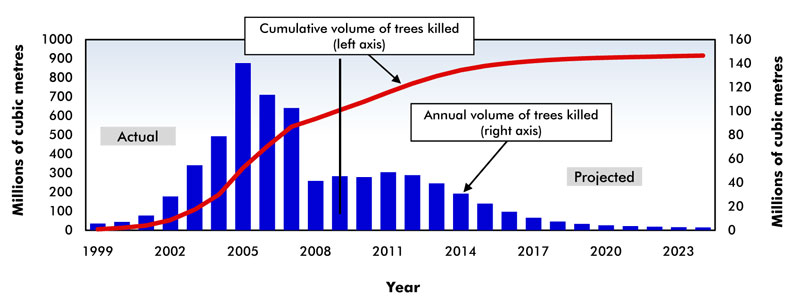Lumber supply, employment in B.C. will feel mountain pine beetle’s bite
-----------------
One of the major clouds hanging over British Columbia’s economy and forest products industry is uncertainty about the mountain pine beetle epidemic.
To date, the pine beetle has killed an estimated 50% of the province’s mature lodgepole pine.
In a recent economic analysis that focused on the pine beetle epidemic, Central 1 economist Bryan Yu noted that over the past 90 years there have been four or five major mountain pine beetle infestations.
However, the current infestation, which started in 1999 and has been exacerbated by a series of relatively mild winters (extreme cold temperature of -35 to -40 degrees Celsius normally kills large numbers of pine beetle eggs and larvae), is the most serious.
According to the Canadian Forest Service, modern forest fire suppression techniques have reduced the number of naturally occurring wildfires. This has resulted in an increased population of mature trees that are more prone to beetle infestation.
The pine beetle infestation is almost exclusively concentrated in the interior region of B.C., which is home to 99% of the province’s mature lodgepole pines.
According to the BC Forest Service, the current pine beetle infestation peaked in 2005 and it will take another 14 years to run its course.
Based on this projection, by 2024, 69% of mature lodgepole pines in the B.C. interior will be killed. This represents 20% of the province’s total timber harvest land base.
In order to reduce the amount of timber lost due to the pine beetle, the province has authorized increased annual allowable cuts in heavily affected areas.
While this increase will support employment and possibly depress prices in the near term, the drop in supply of pine is likely (in five to 10 years) to have a significant negative impact on employment in communities in the interior as well as on downstream forestry-related industries.
According to a recent report by Wood Market, this reduction in lumber harvesting and sawmill activity will also put upward pressure on lumber prices, as well as on prices of residual products such as pulp and paper and residual wood chips.
John Clinkard has over 30 years’ experience as an economist in international, national and regional research and analysis with leading financial institutions and media outlets in Canada.
Cumulative and annual volume of trees killed by the mountain pine beetle
(million cubic metres)

---------------

